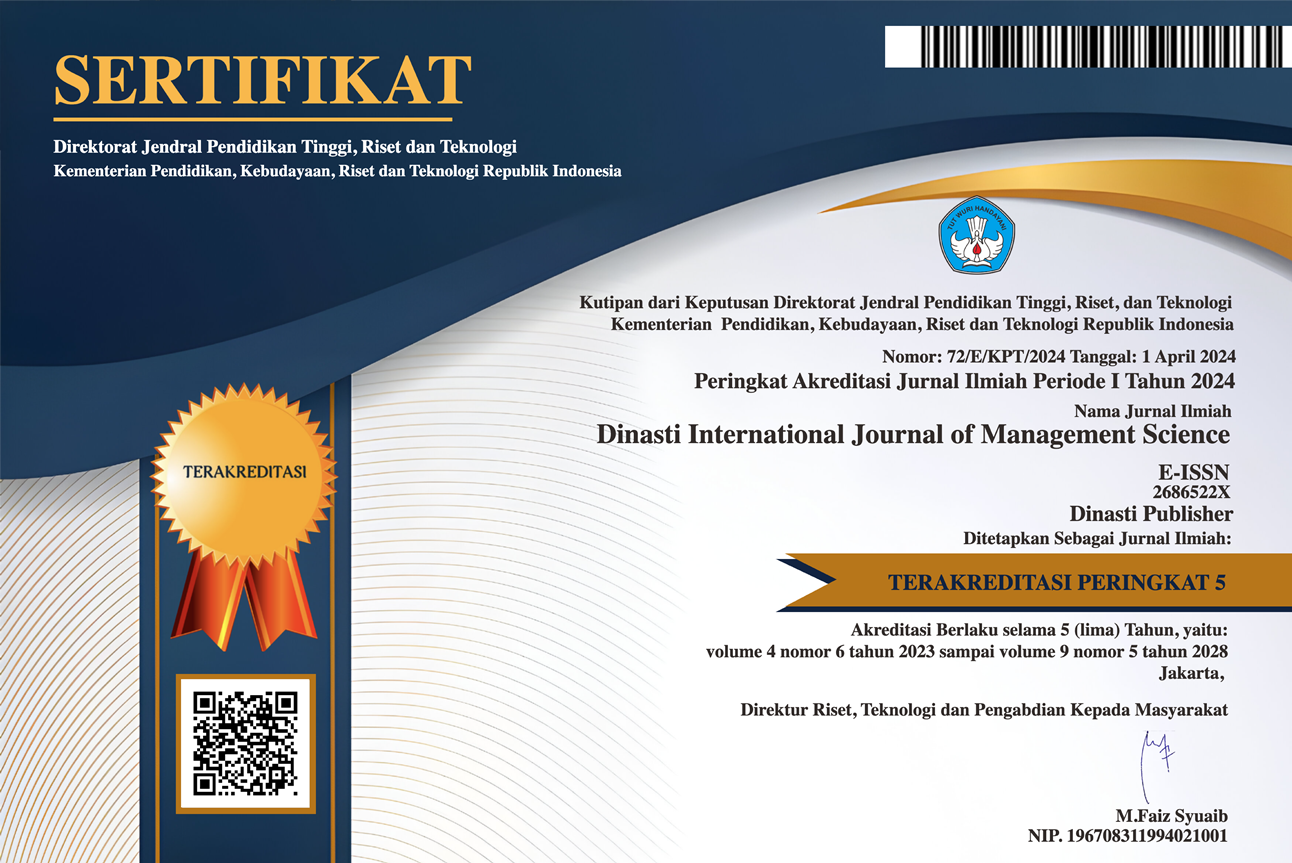Identification of Container Damage During Loading and Unloading on Full Geared Container Deck Vessels: USG Method
DOI:
https://doi.org/10.38035/dijms.v5i6.3196Keywords:
Damage, Containers, Maritime Transport, HandlingAbstract
This study examines the factors that cause damage to containers during the loading and unloading process on full geared container deck ships with port destinations including Pasir Panjang Port (Singapore), Laem Chabang Port (Thailand), and Penang Port (Malaysia) and determines the priority problems that must be resolved immediately. This research uses mixed methods by combining quantitative and qualitative methods with an explanatory sequential design. The quantitative analysis used is the Urgency, Seriousness, and Growth (USG) method. Qualitative methods used observation, interviews, and documentation. The sample used is container damage on the MV. SS in the period August 2018 to August 2019. Causes of container damage during the loading and unloading process on the ship include the lack of supervision and concern of the crew for the security of containers during the loading and unloading process on the ship. From the results of USG method, it was found that container security activities were disrupted due to the duty crew participating in routine ship activities while at the port, even though the duty crew was fully responsible for reefer plug/unplug activities. Furthermore, there is no monitoring of the availability of loading and unloading equipment carried out by the crew so that the ship does not know the real number of lashing equipment on board.
References
Adam, W. N., Suryani, W., & Tarigan, E. S. D. (2021). Pengaruh Pengembangan Sumber Daya Manusia dan Kompetensi Karyawan terhadap Kinerja Karyawan di Hotel Niagara Parapat Toba Sumatera Utara. Jurnal Ilmiah Manajemen Dan Bisnis (JIMBI), 2(1), 41–50. https://doi.org/10.31289/jimbi.v2i1.463
Alattas, S. S., Dwikora Simanjuntak, P., Suhartini, C., & Fahcruddin, I. (2023). Maintenance of Steam Bottle Water to Keep Operational Auxiliary Steam Bottles on The Mv. Ile De Re. 2(2). https://doi.org/10.38035/ijam.v2i2
Bilican, M. S., Karatas, M., Zheng, Y. J., Turan, H. H., & Deveci, M. (2024). A survey of shipping line Container Stowage Planning problems. In Expert Systems with Applications (Vol. 255). Elsevier Ltd. https://doi.org/10.1016/j.eswa.2024.124408
Budiyanto, M. A., Habibie, M. R., & Shinoda, T. (2022). Estimation of CO2 emissions for ship activities at container port as an effort towards a green port index. Energy Reports, 8, 229–236. https://doi.org/10.1016/j.egyr.2022.10.090
Castrellon, J. P., Sanchez-Diaz, I., Roso, V., Altuntas-Vural, C., Rogerson, S., Santén, V., & Kalahasthi, L. K. (2023). Assessing the eco-efficiency benefits of empty container repositioning strategies via dry ports. Transportation Research Part D: Transport and Environment, 120. https://doi.org/10.1016/j.trd.2023.103778
Gattuso, D., & Pellicanò, D. S. (2023). Perspectives for ports development, based on automated container handling technologies. Transportation Research Procedia, 69, 360–367. https://doi.org/10.1016/j.trpro.2023.02.183
Indrawan, D., & Jalilah, S. R. (2021). Metode Kombinasi/Campuran Bentuk Integrasi Dalam Penelitian. Jurnal Studi Guru dan Pembelajaran, 4(3), 735–739. https://doi.org/10.30605/jsgp.4.3.2021.1452
Januarny, T. D., & Harimurti, C. (2021). Pengaruh Tata Letak Gudang Terhadap Kelancaran Produktivitas Bongkar Muat di Gudang PT. NCT. In Jurnal Logistik Indonesia (Vol. 5, Issue 1). http://ojs.stiami.ac.id
Jiang, X., Zhong, M., Shi, J., & Li, W. (2024). Optimization of integrated scheduling of restricted channels, berths, and yards in bulk cargo ports considering carbon emissions. Expert Systems with Applications, 255. https://doi.org/10.1016/j.eswa.2024.124604
Jin, J., Cui, T., Bai, R., & Qu, R. (2024). Container port truck dispatching optimization using Real2Sim based deep reinforcement learning. European Journal of Operational Research, 315(1), 161–175. https://doi.org/10.1016/j.ejor.2023.11.038
Kim, G. S., Lee, E. S., & Kim, B. K. (2022). Strategic port management by consolidating container terminals. Asian Journal of Shipping and Logistics, 38(1), 19–24. https://doi.org/10.1016/j.ajsl.2021.11.003
Mako, P., Dávid, A., & Olei, A. B. (2021). Possibilities of increasing the throughput of ports. Transportation Research Procedia, 55, 426–433. https://doi.org/10.1016/j.trpro.2021.07.006
Moros-Daza, A., Castro, D., Bonifacio, J., Amaya-Mier, R., & Voß, S. (2024). Greening container terminals: An innovative and cost-effective solution for sustainable reefer container storage. Journal of Cleaner Production, 466. https://doi.org/10.1016/j.jclepro.2024.142664
Oktavia, N., Marimin, M., & Arkeman, Y. (2020). Strategi Peningkatan Kinerja Operasional Bongkar Muat Peti Kemas: Studi Kasus di PT Jakarta International Container Terminal. Jurnal Aplikasi Bisnis Dan Manajemen. https://doi.org/10.17358/jabm.6.2.344
Priyadi, A. A., Fahcruddin, I., Almuzani, N., & Gupron, A. K. (2021). Beyond Standard: Do the Marine Engine Officers Competence? 57–63. https://doi.org/10.5220/0010038100570063
Setiawan, F., Fatnanta, F., Jurusan Teknik Sipil, M., & Jurusan Teknik Sipil, D. (2016). Identifikasi Faktor-Faktor Yang Mempengaruhi Nilai Idle Time (IT) dI Pelabuhan Dumai (DERMAGA). In Jom FTEKNIK (Vol. 3, Issue 1).
Utari, E., Wahyuni, I., Sultan, U., & Tirtayasa, A. (2020). Analisis Matriks USG (Urgency, Seriousness And Growth) Banten Mangrove Center Bagi Masyarakat Kelurahan Sawah Luhur Kecamatan Kasemen Kota Serang. Jurnal Biologi dan Pembelajarannya, 15(2).
Van Twiller, J., Sivertsen, A., Pacino, D., & Jensen, R. M. (2024). Literature survey on the container stowage planning problem. In European Journal of Operational Research (Vol. 317, Issue 3, pp. 841–857). Elsevier B.V. https://doi.org/10.1016/j.ejor.2023.12.018
Downloads
Published
How to Cite
Issue
Section
License
Copyright (c) 2024 Alpensam Binowo Ratunsee, M. Hasim Said, Ahmad Mulkan Azima, Bambang Sumali

This work is licensed under a Creative Commons Attribution 4.0 International License.
Authors who publish their manuscripts in this journal agree to the following conditions:
- The copyright on each article belongs to the author(s).
- The author acknowledges that the Dinasti International Journal of Management Science (DIJMS) has the right to be the first to publish with a Creative Commons Attribution 4.0 International license (Attribution 4.0 International (CC BY 4.0).
- Authors can submit articles separately, arrange for the non-exclusive distribution of manuscripts that have been published in this journal into other versions (e.g., sent to the author's institutional repository, publication into books, etc.), by acknowledging that the manuscript has been published for the first time in the Dinasti International Journal of Management Science (DIJMS).
















































